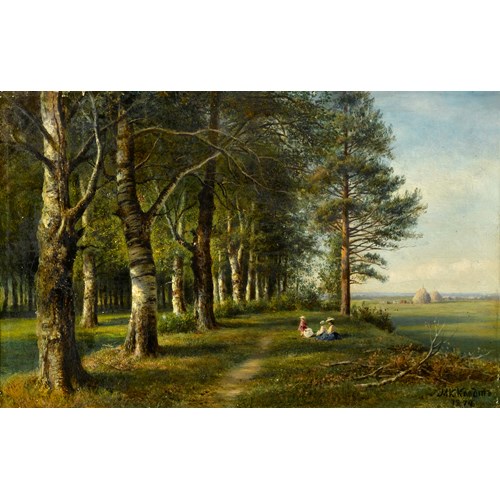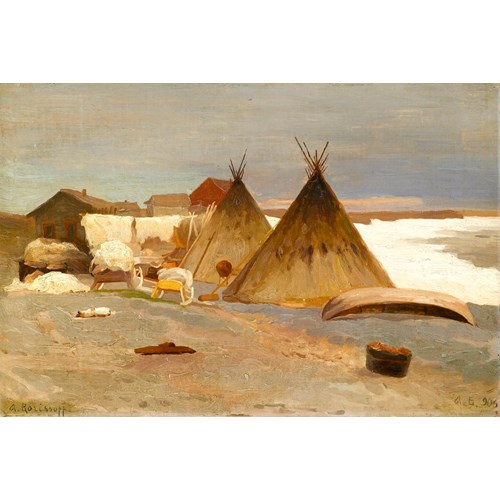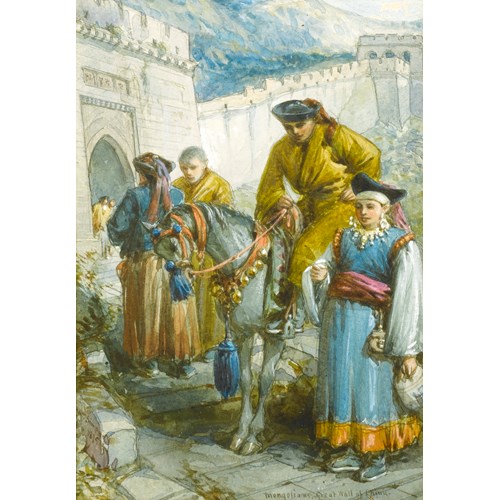William Simpson
Circassia. Tcherkess of the Soubash.
Date 1875
Period 1850-1900, 19th century
Origin England
Medium Pencil, Watercolour on paper
Dimension 17.2 x 12 cm (6³/₄ x 4³/₄ inches)
-The Autobiography of William Simpson, R.I., 1903.
This joyful scene presents us with an intimate glimpse into Circassian (Tcherkess) family life, and also provides us with an illustrative narrative to describe the welcome that William Simpson would have received on his arrival at this particular Circassian village. The chief and his wife look down at their daughter, who proudly holds out a welcome gift. In front of them, two little boys dressed in Circassian coats play; in the background, one can see the thatched huts described by Simpson.
Circassia. Tcherkess of the Soubash, relates to the northern stretch of Simpson’s 1855 trip to Circassia with the Duke of Newcastle. Rather curiously, it is dated exactly twenty years later. As with other works belonging to the original series, the present watercolour, Circassia. Tcherkess of the Soubash, was executed using the preliminary sketches which Simpson made during the 1855 trip.
The intimacy of the subject matter in Circassia. Tcherkess of the Soubash contrasts with the more historical scenes which Simpson was commissioned to produce for the Duke, of which Circassians at the Fort of Waia, 8th October 1855 is an example. We can therefore assume that Simpson had never intended for Circassia. Tcherkess of the Soubash to form part of that original group; this would explain why he did not immediately transform the sketch into a watercolour on his return from Circassia.
In his autobiography, Simpson provides a detailed and reflective account of his trip to Circassia. The contemplative mood indicates that the voyage had a profound effect on him and perhaps goes some way to explain why he returned to the subject matter some twenty years later to produce it as a print in his Picturesque People: Being Groups from all Quarters of the Globe (1876).
Simpson’s accompanying text to the present watercolour provides us with some wonderful prose describing the hospitality of the Circassians, and their customs, explaining how a sheep or calf would be killed in honour of the guests, and that ‘the highest compliment we could pay our guest was to take up a piece of the fattest of the meat in our fingers, and present it to him; on receiving it he would retire into a corner of the apartment, and with his back to us eat the proffered morsel.’¹
From the title of the watercolour, one can assume that the area from which these particular Circassians were from was nearby the River Subash. The river flows into the sea at the former site of Fort Goloven, which itself was the scene of heavy fighting between the Circassians and the Russians. Within a few years of Simpson’s original 1855 trip, the Russians had defeated the Circassians. Simpson reflects on this in the 1876 text that accompanies Circassia. Tcherkess of the Soubash and notes, ‘they had a saying among themselves “That the Russian cart would ultimately beat the Circassian hare in the race,” meaning that no matter how brilliant and brave their own acts might be, the slow progress of their enemies was sure, and must gain its object at last.’²
¹ Simpson, W., Picturesque People: Being Groups from all Quarters of the Globe, (London, 1876).
² ibid.
Date: 1875
Period: 1850-1900, 19th century
Origin: England
Medium: Pencil, Watercolour on paper
Signature: Signed and dated ‘Wm. Simpson. 1875’ (lower right) and inscribed ‘Circassians’ (lower left), signed again ‘Wm. Simpson.’ and inscribed as titled on The Fine Art Gallery label (on the reverse).
Dimension: 17.2 x 12 cm (6³/₄ x 4³/₄ inches)
Provenance: The Fine Art Gallery.
Literature: W. Simpson, Picturesque People: Being Groups from all Quarters of the Globe, 1876, where illustrated as a print, plate 3, with the same title.
More artworks from the Gallery









